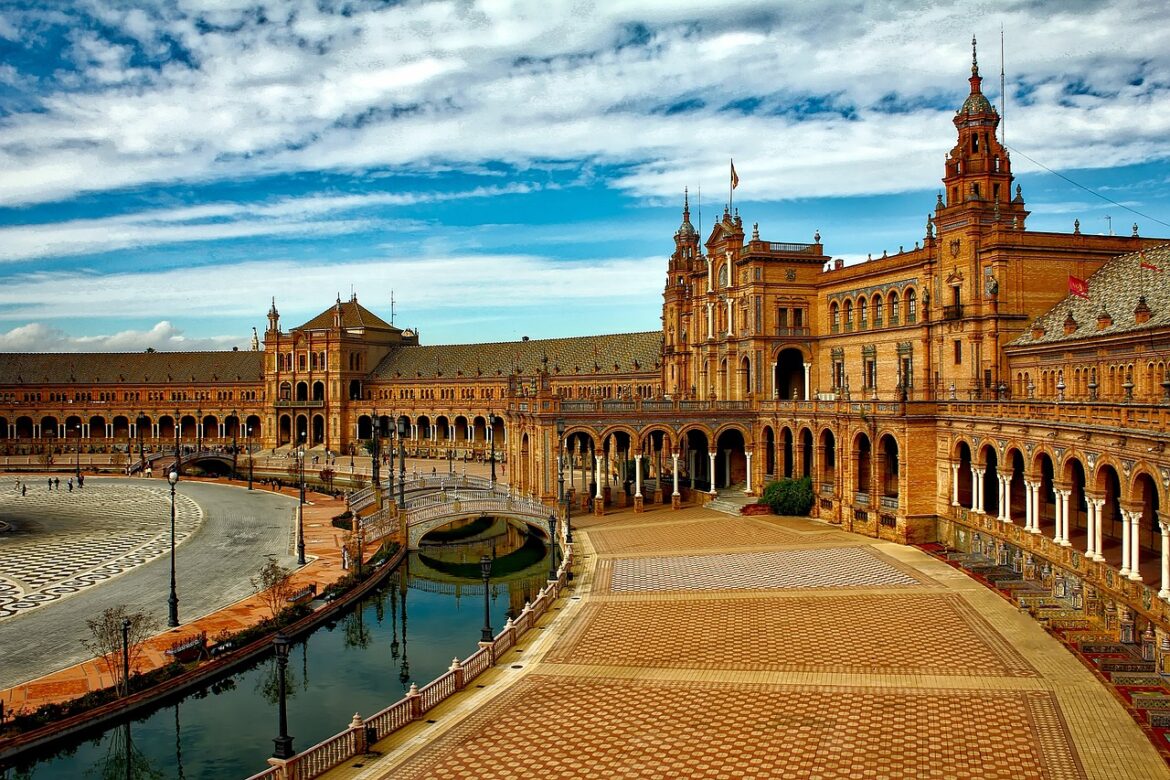Spain’s rich cultural and historical heritage is nowhere more apparent than on the journey from Madrid to Seville, a route that takes travelers deep into the heart of Spain’s most storied regions. This path is one that weaves through centuries of history, from the reign of ancient Iberian tribes and Roman rule to the height of Moorish influence and the splendors of the Spanish Renaissance. As you venture from the cosmopolitan buzz of Madrid, through the grand cities and serene countryside of Castile-La Mancha and Andalusia, you will discover towns that reflect Spain’s diverse architectural heritage, its vibrant artistic traditions, and its deep connection to both Moorish and Christian legacies. Each stop offers a new chapter in Spain’s story, from grand cathedrals to fortified castles and lush, aromatic gardens. Join us on a journey through six of Spain’s most historic and culturally significant destinations as we explore the route from Madrid to Seville.
1. Madrid: The Vibrant Capital with a Regal Past
Your journey begins in Madrid, Spain’s bustling capital, a city that perfectly balances its royal history with modernity. Madrid is a city of grand boulevards, majestic squares, and a treasure trove of artistic masterpieces. The capital was established as the seat of power in 1561 by King Philip II, and since then, it has grown into a major European metropolis that proudly preserves its royal heritage. The Royal Palace, one of the most opulent in Europe, is an excellent starting point to delve into Madrid’s regal past. Its ornate rooms, luxurious tapestries, and priceless collections of art give a glimpse into the lives of Spain’s monarchs. Just across from the palace is the Almudena Cathedral, a more modern masterpiece that took over a century to complete. This stunning cathedral blends various architectural styles, with its neo-Gothic interior and contemporary stained-glass windows offering a fusion of old and new.
Madrid is also home to some of the world’s most significant art collections. The Prado Museum houses works by Spanish masters such as Velázquez, Goya, and El Greco, and wandering its grand galleries offers an in-depth view of Spain’s artistic heritage. Just a short walk away, the Thyssen-Bornemisza Museum and Reina Sofía Museum complete Madrid’s Golden Triangle of Art, with collections that span from the Renaissance to modernism, featuring works by Picasso, Dalí, and Miro. After immersing yourself in the arts, Madrid’s historic neighborhoods, such as La Latina and Lavapiés, beckon with their lively streets, tapas bars, and a taste of Spain’s more laid-back, traditional culture. Madrid serves as the perfect starting point for your journey south, encapsulating the grandiosity of Spain’s imperial past and the creative spirit of its people.
2. Toledo: The City of Three Cultures
A short distance from Madrid, the city of Toledo rises above the Tagus River, a living museum of Spain’s multicultural past. Known as the “City of Three Cultures,” Toledo was once a place where Christians, Jews, and Muslims lived together, contributing to its unique architectural and cultural heritage. Upon entering the city through its grand Puerta de Bisagra, you step into a world that feels frozen in time, with its winding medieval streets, ancient synagogues, mosques, and churches.
At the heart of Toledo is the Toledo Cathedral, a Gothic masterpiece that is one of the most impressive in Spain. Its towering spires and intricate stonework dominate the skyline, while its interior is a marvel of religious art, with works by El Greco, Toledo’s most famous artistic resident. Not far from the cathedral is the Monastery of San Juan de los Reyes, built by the Catholic Monarchs, Ferdinand and Isabella, to commemorate their victory over the Portuguese. This stunning Gothic-Isabelline structure, with its delicate cloisters and hanging chains from Christian prisoners, is a testament to Spain’s turbulent history.
Toledo’s Jewish quarter offers another layer of history, with the Synagogue of Santa María la Blanca, a striking blend of Moorish and Jewish design, and the El Transito Synagogue, now home to the Sephardic Museum, which tells the story of Spain’s Jewish community. The city’s Alcázar, perched on a hill overlooking the river, is another symbol of Toledo’s military importance throughout the centuries. Whether exploring its multicultural past, marveling at its religious architecture, or wandering through its narrow, cobblestone streets, Toledo is a city that encapsulates the rich cultural mosaic of Spain’s history.
3. Córdoba: A Jewel of Moorish Spain
Continuing south, the city of Córdoba stands as one of the finest examples of Spain’s Moorish heritage. Once the capital of the Islamic Caliphate of Córdoba, the city was a center of learning, culture, and architectural brilliance during the Moorish rule of Spain. At its heart is the Mezquita-Catedral de Córdoba, a breathtaking structure that perfectly symbolizes the blend of Christian and Muslim influences. Originally built as a mosque in the 8th century, the Mezquita was transformed into a cathedral after the Reconquista, and today, its forest of red-and-white arches and soaring ceilings create one of the most mesmerizing interiors in the world.
Córdoba’s Jewish Quarter is another highlight of the city, with its narrow, whitewashed streets, charming courtyards, and historic synagogues that tell the story of the city’s Jewish community. The Calleja de las Flores, a picturesque alley lined with flowers, offers a perfect view of the Mezquita’s tower, while the Alcázar de los Reyes Cristianos, a fortress that was once home to the Christian monarchs, boasts beautiful gardens and fountains reminiscent of the Alhambra. Córdoba is also famous for its patios, ornate courtyards filled with flowers and fountains, which come alive during the city’s annual Patio Festival, a UNESCO-listed celebration of Andalusian culture.
Walking through Córdoba is like stepping back in time to the days of Moorish Spain, where Islamic, Jewish, and Christian cultures thrived together. The city’s rich architectural and cultural heritage offers a glimpse into the splendor of one of the most powerful cities of the medieval world, and its beautifully preserved historic center continues to enchant visitors from around the globe.
4. Jaén: Land of Castles and Olive Groves
As you venture further into Andalusia, the landscape begins to change, with the rolling hills giving way to endless fields of olive trees, which define the province of Jaén. Known as the “Land of Castles and Olive Groves,” Jaén is famous for its olive oil production and boasts the highest concentration of castles in Europe. Dominating the city of Jaén is the Castle of Santa Catalina, a fortress that offers panoramic views of the surrounding countryside. The castle’s strategic location has made it a vital defensive stronghold throughout history, and its well-preserved walls and towers offer visitors a chance to explore its turbulent past.
Jaén is also home to one of Spain’s most impressive cathedrals, the Jaén Cathedral, a masterpiece of Renaissance architecture. Its grand façade and towering columns are a testament to the city’s importance during Spain’s Golden Age. Beyond its historical landmarks, Jaén’s olive oil is a major draw for visitors, and the region’s olive oil museums and tastings provide an opportunity to learn about and sample the “liquid gold” that has been produced here for centuries.
While Jaén may not be as famous as some of its neighboring cities, its rich history, stunning landscapes, and world-class olive oil make it a hidden gem worth discovering. It’s a place where you can experience the slower, more rural side of Andalusia, while still uncovering centuries of history and culture.
5. Granada: The Moorish Crown Jewel
As you continue south, the city of Granada beckons with its iconic Alhambra, a stunning palace and fortress complex that is considered one of the greatest architectural achievements of Moorish Spain. Perched on a hilltop overlooking the city, the Alhambra is a UNESCO World Heritage site and a symbol of the rich Islamic legacy that once flourished in Andalusia. The Alhambra’s intricately decorated palaces, serene courtyards, and lush gardens transport visitors to the height of the Nasrid Dynasty, when Granada was the last Muslim kingdom in Spain.
Beyond the Alhambra, Granada’s Albaicín neighborhood is another treasure of Moorish Spain. This historic district, with its narrow, winding streets and whitewashed houses, offers breathtaking views of the Alhambra and the Sierra Nevada mountains. The Generalife Gardens, once the summer residence of the Nasrid rulers, provide a peaceful escape with their meticulously designed landscapes and reflecting pools. Granada is also famous for its vibrant flamenco scene, particularly in the caves of the Sacromonte district, where the passionate music and dance form originated.
Granada’s fusion of Moorish and Christian architecture, its stunning natural setting, and its rich cultural traditions make it one of the most enchanting stops on the journey through Spain’s cultural heartland. It’s a city where the past is always present, and where the legacy of Moorish Spain continues to inspire awe.
6. Seville: The Grand Finale of Andalusia
The final stop on this cultural journey is Seville, the capital of Andalusia and a city that embodies the essence of southern Spain. Known for its grand architecture, lively festivals, and deep cultural traditions, Seville is a city that captivates all who visit. At its heart is the Seville Cathedral, the largest Gothic cathedral in the world and the final resting place of Christopher Columbus. Its towering Giralda bell tower, originally built as a minaret for the city’s mosque, offers panoramic views of Seville’s orange-lined streets and iconic landmarks.
Next to the cathedral is the Alcázar of Seville, a royal palace that was once home to Moorish rulers and later to Spanish monarchs. Its stunning Mudejar architecture, with its intricate tilework and peaceful courtyards, rivals the Alhambra in its beauty. The Plaza de España, an enormous semi-circular square built for the 1929 Ibero-American Exposition, is another must-see, with its beautiful bridges, tiled alcoves representing Spain’s provinces, and its large fountain surrounded by a canal.
Seville is also famous for its lively cultural scene, particularly its annual Feria de Abril and Semana Santa celebrations, which showcase the city’s deep connection to its traditions. Whether exploring its grand monuments, enjoying tapas in the Barrio Santa Cruz, or watching a fiery flamenco performance, Seville offers a perfect finale to this cultural journey through Spain.
Conclusion
From the bustling streets of Madrid to the sun-soaked squares of Seville, this journey through Spain’s cultural heartland offers a deep dive into the country’s rich history and traditions. Each stop along the way tells a unique story, from the multicultural heritage of Toledo and Córdoba to the Moorish splendor of Granada and Seville. Along this route, travelers can witness the incredible diversity of Spain’s architecture, art, and culture, while also experiencing the warmth and hospitality of its people. Whether you are exploring grand cathedrals, ancient palaces, or enjoying the simple pleasure of a meal in a traditional Spanish town, this journey will leave you with a profound appreciation for the beauty and history of Spain’s most iconic destinations. As you make your way from Madrid to Seville, you will discover that Spain’s cultural route is not just a path through history, but a journey into the soul of the nation itself.
Learn More


